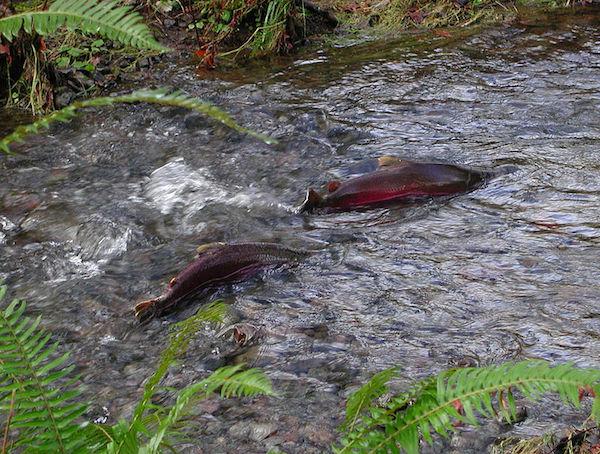‘Disastrous’ Coho Returns Threaten Western Washington Tribes

Blame it on the mass of water known as "the Blob”—four-plus degrees Fahrenheit, warmer-than-normal, nutrient-poor ocean waters hugging the Pacific coast—or on El Niño, habitat destruction or toxic runoff. Whatever the cause of dwindling coho salmon runs, the effect on western Washington tribal fishing nations can be summed up in one word: disastrous.
It's so serious that there likely will be no coho fisheries in 2016, as returns are expected to plummet even further than those of last year because of poor ocean survival, wrote Lorraine Loomis, chair of the Northwest Indian Fisheries Commission (NWIFC) in her March "Being Frank" column in the North Kitsap Herald.
Some treaty tribes lean more on certain salmon species than others—but all rely on the coho. For the Stillaguamish Tribe, bound by treaty to fish only in their home river, last year's poor coho runs and this year’s low coho forecasts pose what could be an insurmountable threat to their culture and way of life.
Losing the salmon means losing their culture, Shawn Yanity, chairman and fisheries manager for the Stillaguamish Tribe of Indians, told the Everett Herald.
“They’ve always fed our people. They’re one of the links between us and the river,” he said. "They’re in our songs, they’re in our stories, they’re in our creation.”
Coho returns in 2015 were as much as 80 percent below pre-season forecasts. Jolting in terms of cultural impacts was news that the Nisqually Tribe canceled its coho fishery last year when fewer than 4,000 of the 23,000 fish expected actually returned, as did the Squaxin Island and Puyallup tribes. The cancelations were to ensure that enough adult salmon would make it back to produce the next generation throughout South Puget Sound. It was the same story in many tribal fishing areas in western Washington, Loomis wrote.
RELATED: Situation 'Dire': Low Coho Salmon Returns Close Quinault Fisheries
Tribal and state fishery managers, tasked with determining how best to manage Washington's fisheries, proposed a zero option that would close all ocean salmon fisheries in state waters at the urging of the NWIFC, which represents 20 western Washington treaty fishing tribes.
"The Puget Sound coho returns were so bad so early on, we wanted to set the tone for this," said Tony Meyer, NWIFC public information officer. "That's significant. Nobody wants to have that discussion."
Two other alternatives that would allow for some fishing were also approved for public review by the Pacific Fishery Management Council (PFMC), which establishes fishing seasons in ocean waters. A final decision is expected in mid April.
Loomis said it's their hope that it won't come to the zero option.
"Our cultures, treaty rights, and economies depend on salmon. But the resource must come first," she said in a statement.
"We face an extraordinary conservation challenge this year," Loomis said. "In many instances returns will likely be far below minimum levels needed to produce the next generation of salmon. Conservation must be our sole focus as we work to rebuild these stocks.”
PFMC’s executive director Donald McIsaac affirmed Loomis's concern.
“Expectations for wild coho runs in the Washington Coast and Puget Sound areas can only be described as disastrous,” he said on the PFMC website.
“Fishery managers face many difficult decisions in the weeks ahead as we move toward solidifying salmon-fishing seasons for the state,” Jim Unsworth, director of the Washington Department of Fish and Wildlife said in a statement. “We know that severely limiting opportunities will hurt many families and communities that depend on these fisheries. But conserving wild salmon is our top priority and is in the best interest of future generations of Washingtonians.”
Nor can hatchery coho make up for the loss of wild coho, as both are equally at risk.
Since all coho share the same diets, the ocean conditions negatively affecting wild coho survival are having the same impact on hatchery coho survival. Warmer water in the ocean leads to less availability of nutrient-rich cool water for all coho, which means a return consisting of fewer, smaller and less healthy fish—both wild and hatchery.
If hatcheries don’t see enough fish this fall to get as many eggs as they need, future runs won’t be as large. Smaller runs could result even six or nine years from now because the right decision wasn’t made this year, NWIFC said.
“We don’t know how many we’ll see, we don’t know how healthy they’ll be, and we don’t know how many eggs they’ll have,” Loomis said. “That means we need to be careful, because if we don’t know how healthy these fish are when they come back, a lot of damage could be done.
“We have never seen runs this low, so we don’t know how well they might bounce back,” Loomis said. “Zero must be the starting place for fisheries management planning this year.”
If the zero option is adopted, it won't be the first time. In what was then an unprecedented move, the PFMC adopted a “zero option” plan that closed ocean fishing for all salmon species owing to poor projections for coho and chinook salmon in 1994.
Read more at http://indiancountrytodaymedianetwork.com/2016/03/28/disastrous-coho-returns-threaten-western-washington-tribes-163942